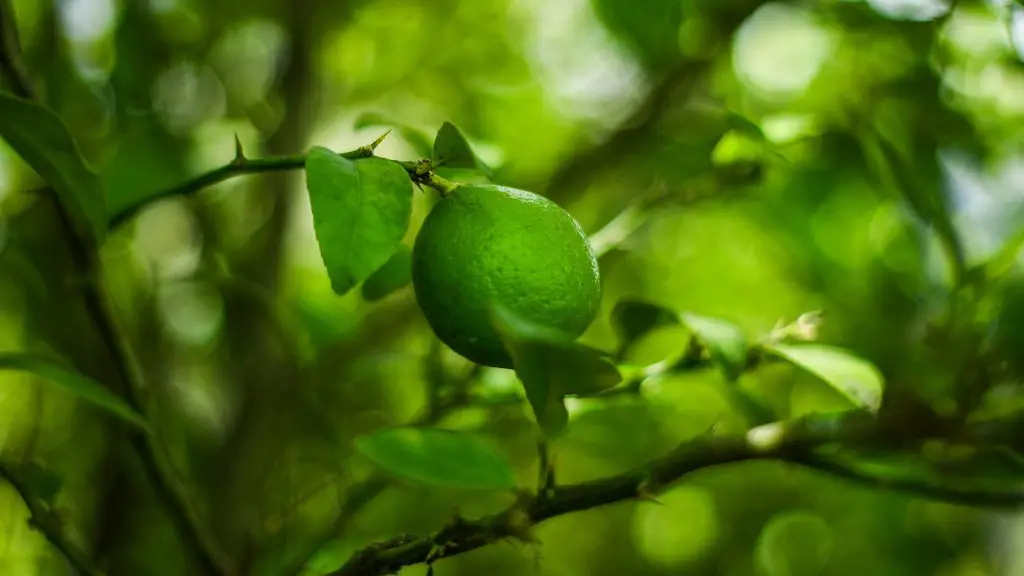A lemon tree can produce fruits anywhere between two and four years after being planted. However, there are several variables which can affect the amount of time it takes for a lemon tree to bear fruit. Soil fertility, amount of sunlight and irrigation are all key factors in how soon a lemon tree will mature and be able to produce fruit.
For instance, the fertility of the soil will influence the rate in which a lemon tree will grow, as the roots will draw in nutrients from the soil which are used for growth of the lemon tree. If the soil is abundant with the necessary minerals, such as nitrogen and magnesium, the expedite the development of the tree and thus reduce the amount of time until the tree can produce fruits.
Adequate sunlight will also help to speed up the process of the lemon tree maturing. As the tree grows, it will need a consistent supply of sunlight in order to thrive. If the tree is in an area with a lot of shade, it might take longer for it to bear fruit as the foliage will not be able to develop as quickly.
Finally, the amount of water a lemon tree is exposed to also plays a key role in the productivity of the tree. A lemon tree will require a consistent source of water which allows the roots to absorb the necessary nutrients and to produce the fruits. Thus, if the water is not adequately replenished, the tree may take longer to mature and bear fruits.
Effect of climate
Another factor to consider is the climate in which the lemon tree is located. If the environment is too cold, then the tree might take longer to produce fruits than it would if the climate was more favourable. The lemon tree needs to be in an environment which is not too wet, not too cold and not too dry in order to truly flourish.
The colder climate may weaken the trunk of the tree and put pressure on the flowers and leaves, which may result in a slower ripening process and a longer time until the fruit is ready for harvesting. Similarly, too dry of an environment may also cause the tree to take longer to reach its full potential as the water supply and nutrients may become limited.
It is important for growers to be aware of the two or four year estimate for lemon trees and to do their best to provide the necessary factors for the tree to reach its full potential. Being mindful of the climate, the soil fertility, the water intake and the sunlight will all help the tree to produce fruits more quickly, as well as improve the overall quality of the fruits.
Time required for different varieties
It is also important to note that certain varieties of lemon tree may take longer to ripen than others, due to variations in their genetic makeup. For example, the Meyer lemon tree may take a little longer to produce fruits compared to the regular lemon variety. Growers will need to take extra precautions such as providing more fertile soil and proper temperatures for the tree in order for it to reach its full potential.
Trees which are grown from a container, rather than from the ground, may also take longer to bear fruit as the soil may not be as rich and the sapling is not receiving the necessary nutrients from the soil. Taking the above factors into consideration can ultimately help speed up the process of a lemon tree maturing and producing fruits.
Pruning tips
Those who are in charge of caring for a lemon tree should be aware of some crucial pruning tips to keep in mind. Pruning a tree is necessary for lemon trees, as it helps to improve the shape and size of the plant, as well as promote healthier growth. Pruning also reduces the risks of pest infestations and disease.
Additionally, pruning will help to focus the growth in one particular direction and will keep the busy branches from overextending outward. This in turn allows for the tree to strengthen, which can help to accelerate the maturation and fruit-producing process of the lemon tree. Pruning should be done regularly in order to ensure that the tree does not become overgrown.
Crop yields and harvest
Once the lemon tree has ripened and produced fruits, the harvest needs to be done with utmost care in order to ensure optimal freshness and taste. Using the proper harvesting techniques such as gently picking the fruits and taking only what is needed can guarantee a successful crop yield.
Additionally, if the tree is left with too many fruits, it can be subjected to nutrient deficiency and pest infestations which can greatly reduce the quality and freshness of the fruits. As such, growers must be mindful of the number of fruits they are picking from the tree in order to preserve the quality of the harvest.
Pest monitoring and fertilisation
Monitoring for any possible pest infestations should also be done regularly in order to prevent any damage to the tree. There are several telltale signs which can help determine whether there is a pest infestation such as yellowing of leaves and dull spots on the fruits.
Fertilising the tree on a regular basis is also essential for the growth process and the overall health of the tree. This will provide the tree with an adequate source of nutrients which can help to enhance the quality and freshness of the fruits. Applying slow-release fertilizers such as poultry litter can also help to provide the tree with the necessary minerals to promote healthy development.
Irrigation and care
Finally, a lemon tree should be receiving proper care which includes consistent watering and pruning. Irrigation is important to ensure the tree is receiving enough water to maintain the proper development of the foliage. It is also important to check the soil around the tree to ensure that it is receiving enough moisture.
Pruning is also necessary to maintain the overall shape and size of the lemon tree and to enhance the growth process of the fruit. Removing any excess dead leaves, branches and foliage will help to keep the tree healthy as well as prevent any pest infestations. Additionally, doing a deep pruning can help the tree focus its energy on producing a good crop yield.



